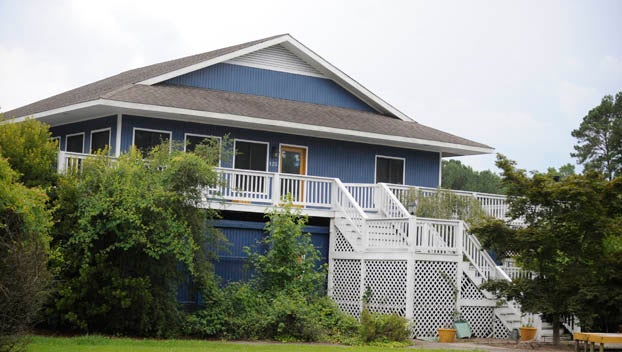City Council again denies subdivision plat
Published 8:22 pm Tuesday, June 15, 2021

- The former Racquet Club of Washington facility is located at 123 Avon Avenue in Washington. (Brandon Tester / Washington Daily news)
|
Getting your Trinity Audio player ready...
|
The developers seeking to turn the property that houses the defunct Racquet Club of Washington into a single-family residential subdivision left City Hall frustrated Monday after the Washington City Council denied a revised version of their preliminary subdivision plat that was turned down in April.
Councilwoman Betsy Kane had an excused absence for Monday’s meeting, and Mayor Donald Sadler recused himself from the agenda item, as he has done in all previous discussions and votes related to Powell Place. That left William Pitt, Virginia Finnerty, Mike Renn and Mayor Pro Tem Richard Brooks to discuss and make a decision on the preliminary plat. Council voted 3-1 in favor of Renn’s motion to deny the planning board’s unanimous recommendation to approve the plat, after Finnerty’s motion to accept the recommendation didn’t receive a second.
BACKGROUND
Bill and Dale Peele have owned the property since 2003. It was most recently used as the Racquet Club, which the Peeles operated until 2017. After temporarily leasing the property, the Peeles shuttered the racquet club due to low membership numbers.
In April, they came to City Council with a preliminary subdivision plat for an 18-lot single-family residential subdivision, Powell Place, that would be built on the former Racquet Club property, which is located near the corner of Avon Avenue and Atkins Drive.
Most of the property is zoned office and industrial. The rest is zoned residential.
At that April meeting, several people came forward to tell City Council not to approve the preliminary plat, citing concerns about city ordinance compliance, neighborhood density and a potential increase in traffic.
Addressing concerns about density, Bill Peele said the plat originally included 22 lots, but it was trimmed down to 18. He said anything lower than that would diminish the economic feasibility of the project. As for the traffic concerns, Marie Peedin of Inner Banks Engineering said a quick traffic study revealed that approximately 800 vehicles travel Avon Avenue on a daily basis, which is less than Brick Kiln Road (3,600) and is comparable to Smaw Road (600).
Kane pointed to two lots branching out from a cul-de-sac on the proposed plat. One of those lots branched so far out that it would only be accessible by way of a connection to Camelia Drive in the Macswoods subdivision. Camelia Drive wouldn’t meet the city’s current subdivision ordinances.
Finnerty eventually motioned to approve the plat on the condition that those two lots would be combined so that both could be accessed from within Powell Place. That motion ultimately failed with a 2-3 vote.
“What is the rationale when we were told they followed the rules, they did everything they were supposed to? I need to know,” Finnerty said. “I don’t understand. It’s very frustrating to me to see people try to do something right by this town. They do everything they’re supposed to, and you sit here and say no to them.”
A MONTH LATER
The Peeles came before City Council again in May and made it known that an attorney was representing them.
Bill Peele presented to City Council two versions of a petition against the Powell Place subdivision. One version, which was presented to the planning board in Feb. 2021, includes the signatures of Mayor Donald Sadler and his wife, Alice Mills Sadler, who reside in an adjacent neighborhood. On the second version, which was presented to City Council in April, Donald Sadler’s signature is whited out.
Bill Peele asked for guidance from City Council. City Attorney Franz Holscher advised Council against responding, given that an attorney — who wasn’t present at that meeting — represented the Peeles.
SECOND TRY
On Monday, the Peeles presented to City Council a revised version of the preliminary plat that had been denied in April. The planning board had unanimously approved the revised plat.
The revised plat included 17 lots. The two branched-off lots Kane mentioned in April had been combined into one space that could be used as a recreational area, should the city decide to purchase it.
The original plat had just one entrance and exit. At the request of the planning board, a second entrance and exit along Avon Avenue was added to the revised proposal.
Director of Community and Cultural Services Mike Dail noted that the preliminary plat didn’t meet a couple of the city’s minor subdivision standards, one being that the length between intersections shouldn’t be less than 300 feet. With the second entrance/exit in place on Avon Avenue, that can’t be achieved.
“There’s been some questions about how the lot lines intersect the streets,” Dail said. “The code requires them to meet at right angles, which is a great requirement, but in the real world it’s really kind of tough to do that a lot of times when you have curves and things in the streets.
“So , in staff’s opinion, it meets the purpose and intent of the ordinance,” he added.
Bill Peele addressed City Council after the presentation, noting that the developers had filed a lawsuit against the city after the first version of the plat was denied in April. They decided to dismiss the lawsuit in May and go through the planning process again “in good faith.”
Alice Phillips came to the podium and said she was speaking on behalf of neighbors around the property. She maintained that the neighbors still were against the Powell Place proposal.
Filling in for Sadler following his recusal, Brooks asked for a motion to either accept or deny the planning board’s recommendation to approve the plat. Finnerty motioned for approval.
After hearing no second, Finnerty again expressed her frustration.
“And again, like before, I have to state that I do not understand that no one has questions, no one has comments, and yet you refuse to do this,” Finnerty said. “It’s mind-boggling to me. I just want to make it clear.”
Renn then motioned to deny the request on the grounds of “noncompliance with the applicable specific standards of the city subdivision ordinance, including but not limited to those highlighted by city staff; inconsistency with general standards … contained in the city’s subdivision ordinance, including but not limited to public safety, traffic density and welfare issues; or the detrimental impact this subdivision would have on surrounding landowners, the nearby community and the character of existing developments in the nearby area.”
NEXT STEPS
Bill Peele said Tuesday morning that he was waiting to speak with an attorney before deciding what to do next.
“I think there’s been a lack of respect for our abilities,” he said. “They just want to do what they want to do, and they want someone to do it, but they don’t own the property — they haven’t made an offer to buy it.
“The thing is, we are the people who own the property and pay the taxes, pay the bank loan to be managing that business, and there seems to be no respect for that,” Peele added. “It’s what the mayor and his wife want — and I think the homeowners in the neighborhood are swayed by that.”




